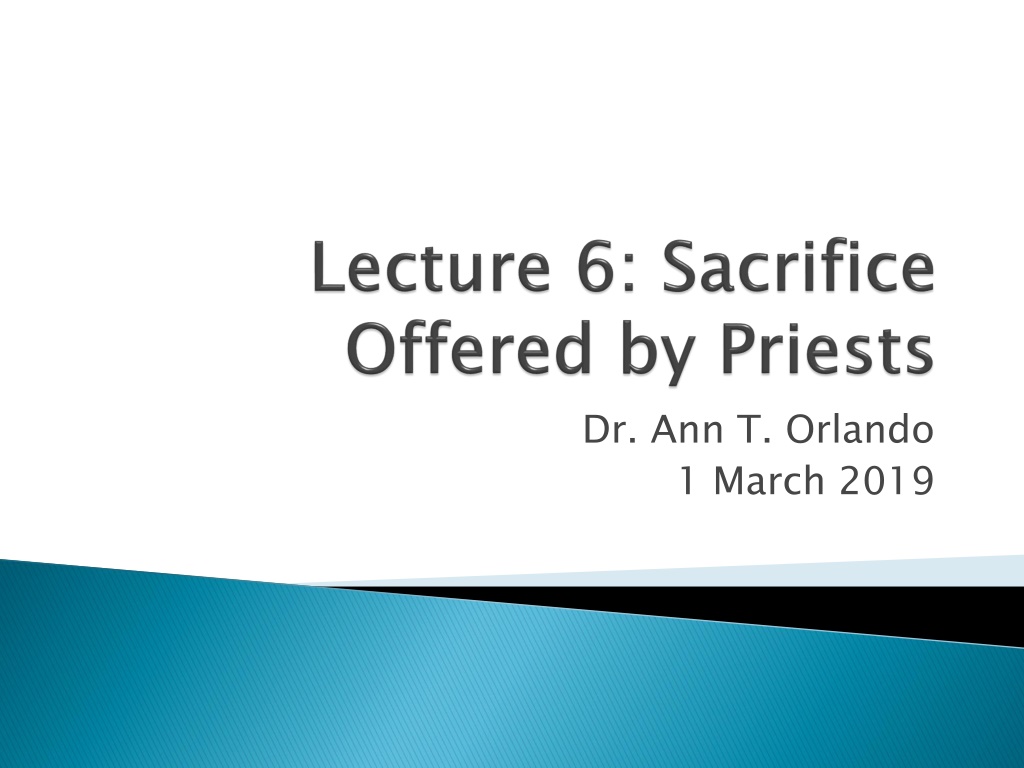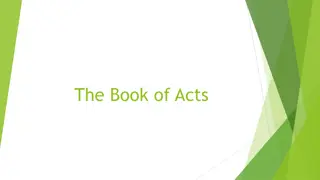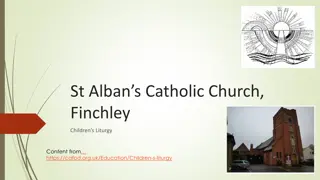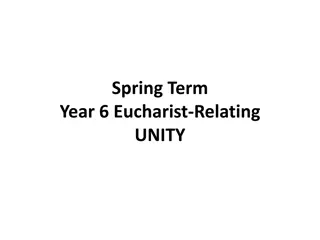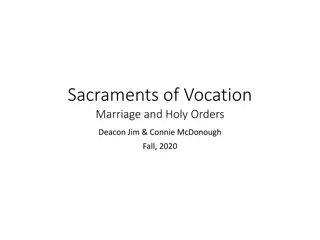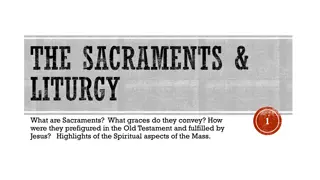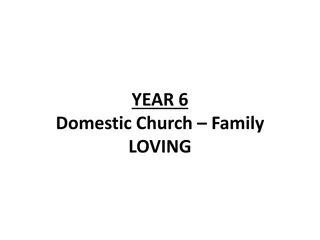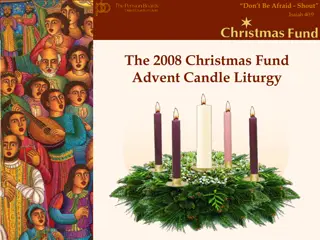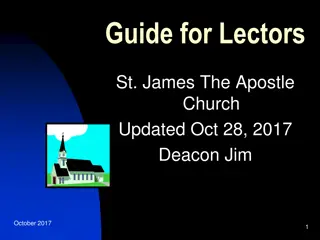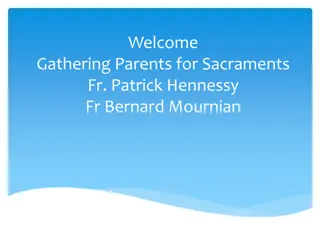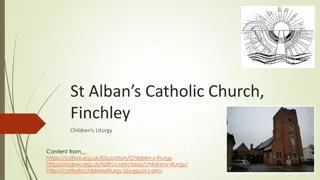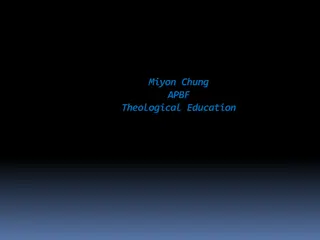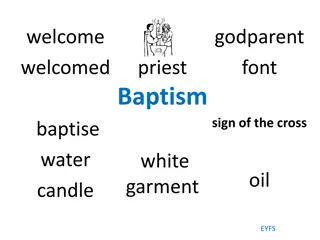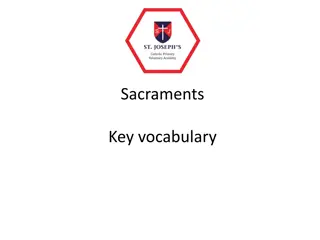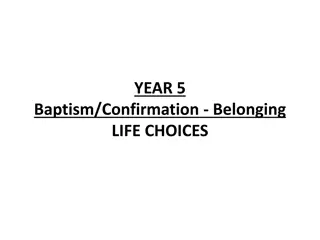Exploring the Depth of Mystery and Sacraments in Christian Liturgy
Delve into the realm of mystery and sacraments in Christian liturgy, from the significance of the Eucharist to the hidden teachings in Plato's philosophy. Discover the roots of mystery cults, the connection of Christ as the mysterion of God, and the practice of thanksgiving prayers in the early Church.
Download Presentation

Please find below an Image/Link to download the presentation.
The content on the website is provided AS IS for your information and personal use only. It may not be sold, licensed, or shared on other websites without obtaining consent from the author. Download presentation by click this link. If you encounter any issues during the download, it is possible that the publisher has removed the file from their server.
E N D
Presentation Transcript
Dr. Ann T. Orlando 1 March 2019
Key words Mystery Eucharist Liturgy Sacrifice Sacrament John Chrysostom Augustine on signs and sacraments Assignments
Mystery cults Group assemblies dedicated to worship of a god Usually requires initiation rite Personal destiny dependent on proper relation to god Hidden or secret writings Examples: Dionysius, Isis and Osiris, Mithras, Gnostics Mysterion in Greek philosophy In Plato, special teachings which elevate the soul toward union with the good and beautiful In neo-Platonism, philosophy leads through stages of mysterion to union with the One In LXX only found in later (Hellenistic) writings See Wis. 14 for a description (and condemnation) of mystery cults, 14:15 and 14:23
In Paul The Christ is the mysterion of God. See 1 Cor 1:23; Col 2:2 The kerygma announces and reveals that mysterion see Eph 3:7-13 In late 2ndC, Justin Martyr and Tertullian compare pagan mysterion activities with the true teaching and sacraments (so Tertullian) of the Church By 4thC Greek-speaking Church is referring to the Eucharist as the mysterion as well as the central statement of faith: passion, suffering and resurrection of Jesus Christ See for instance Gregory Nazianzus, On Flight
Greek LXX Prayer of thanksgiving to a god Thanksgiving as opening to a letter Prayer of thanksgiving, especially in recognition that good things come from God, not ourselves In Psalms, also Wis 16:28 New Testament General prayer of thanksgiving Jn 11:41, Acts 28:15, Rev. 11:17 Prayer before a meal Mk 8:6, Mt 15:36, Jn 6:11, 23; Acts 27:35 Paul Thanksgiving to God for community of Christians as part of preface to letters Prayer of Thanksgiving offered through Jesus Christ, Rom 1:8; thanks to Creator Rom, 1:21 Manner of thanksgiving in the assembly, 1 Cor 14 In early Church As a thanksgiving in preface to letters See for example, Ignatius of Antioch Prayer of thanksgiving during the Lord s Supper Ignatius of Antioch, Didache, Justin Martyr
Greek Literally work of or for the people Becomes associated with a service undertaken for public good In mystery cults, offerings to the gods on behalf of the public good (service) LXX, numerous references Ex 28-29 how Aaron and the Levites are to serve God on behalf of the people Always used of the service of priests in the sanctuary New Testament Luke and Paul Especially in Hebrews, of Christ in His sacrificial death In early Church Service offered by Christian community to God I Clement; Shepherd of Hermas
Fundamental meaning is initiation that has some sacred component (oath) Beginning of a legal proceeding Inducted into the army Early (Old) Latin translations used sacramentum for mysteriov It seems that 2ndC Latin speaking Christians did not want to confuse Christian rites with pagan mystery cults. See Tertullian Prescription Against Heretics, .
Sometime in late 3rd, early 4thC some Christians in Western Roman Empire celebrate liturgy in Latin. Pope Damasus (late 4thC) encouraged Latin usage in the West Word Mass (Missa) Used in 3rdC as dismissal, first of catechumens, then of faithful Used by Sts. Ambrose and Augustine in this context, specifically for dismissal at end of liturgy Eventually (6thC??) becomes Latin for entire Eucharistic celebration NB Ambrose and Augustine refer to the Eucharistic celebration as The Sacrifice Early Liturgies 8
Both On Mysteries and On Sacraments were catechetical instructions from Ambrose Genre of Catechetical instruction Given by a bishop Usually not a sermon, but at a gathering of adults preparing for Baptism, or immediately afterwards Given during Lent and Easter seasons Often bound together and repeated each year On Mysteries given during Lent On Sacraments given in Easter season
Augustine tends to use mysterion as Paul did for doctrinal statements Sacramentum refers to ritual (graceful) actions In Letter 54 he talks about the uncountable number of sacraments in the Old Testament; 54.1.1 By contrast he suggests that the number in the New Testament is very few 54.1.2 The most important sacramentum is the Incarnation; Sermon 341.3.3
Augustines theory of signs developed most fully in De Doctrina Christiana In DDC he applies his theory of signs Scripture (Book II) All language is a sign of some reality (res) Two types of signs in language Signa propria: proper signs as ox Signa translata: metaphorical signs, as ox to mean a minister yoked to Gospel
Signs can also be non-verbal; that is signs can be objects as signa translata: But the Lord himself and the discipline of the apostles has handed down to us a few signs and these so easy to perform, and so awesome to understand, and so pure and chaste to celebrate, such as the sacrament of baptism and the celebration of the Lord s body and blood. When people receive these they can recognize to what sublime realities they refer.
Sermon 227 is a concentrated statement from Augustine on the Eucharist Preached on Easter Sunday, especially directed to the recently baptized. Note the fluid use of signs with respect to the sacrament of the altar
Collection of 124 sermons, often referred to as the Tractates on John s Gospel Preached by Augustine between 405 -420 Collected by Possidius Together they form the first commentary in Latin on John s Gospel Homily 26 and 27 were preached in August on successive days Note importance of receiving worthily
John Chrysostom, Homily 2 on Second Timothy John Chrysostom, Homily XVII.6-10 on Hebrews 9:24-26 (re-read) Ambrose, On Sacraments IV, https://archive.org/stream/fathersofthechur0 12918mbp#page/n329/mode/2up Augustine, Sermon 227 ____ Homilies on John s Gospel, 26 and 27 Prepare Paper #6
